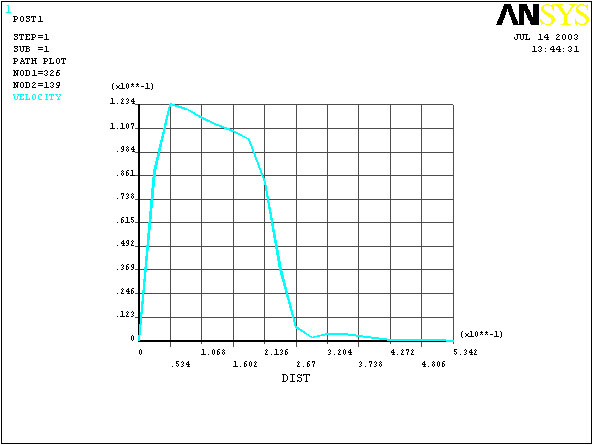Fluid #2: Velocity
analysis of fluid flow in a channel USING FLOTRAN
Introduction:
In this example you will model fluid flow in a channel
Physical Problem:
Compute and plot the velocity distribution within the elbow. Assume that
the flow is uniform at both the inlet and the outlet sections and that
the elbow has uniform depth.
Problem Description:
 |
The
channel has dimensions as shown in the figure |
 |
The
flow velocity as the inlet is 10 cm/s |
 |
Use the continuity
equation to compute the flow velocity at exit |
 |
Objective:
 |
To plot the
velocity profile in the channel |
 |
To plot the
velocity profile across the elbow |
|
 |
You are required to
hand in print outs for the above |
 |
Figure: |

IMPORTANT:
Convert all dimensions and forces into SI units
STARTING
ANSYS
 |
Click on
ANSYS
6.1
in the
programs menu. |
 |
Select
Interactive.
|
 |
The
following menu comes up. Enter the working directory. All your files
will be stored in this directory. Also under
Use
Default Memory Model
make
sure the values
64
for Total Workspace, and
32
for Database are entered. To change these values unclick
Use
Default Memory Model |

MODELING THE STRUCTURE
 |
Go to the ANSYS
Utility Menu (the top bar) |
 |
Click
Workplane>WP
Settings… |
The following window
comes up:

o
Check
the Cartesian and Grid Only buttons
o
Enter
the values shown in the figure above
·
Go to
the ANSYS Main Menu (on the left hand side of the screen) and click
Preprocessor>Modeling>Create>Keypoints>On
Working Plane
Create
keypoints corresponding to the vertices in
the figure. The keypoints look like below.

Now
create lines joining these key points.
 |
Modeling>Create>Lines>Lines>Straight line |
 |
The model looks
like the one below. |

Now
create fillets between lines L4-L5 and L1-L2.
 |
Click
Modeling>Create>Lines>Line Fillet.
A pop-up window will now appear. Select lines 4 and 5. Click OK.
The following window will appear: |

 |
This window assigns
the fillet radius. Set this value to 0.1 m. |
 |
Repeat this process
of filleting for Lines 1 and 2. |
 |
The model should
look like this now: |

 |
Now make an area
enclosed by these lines. |
 |
Modeling>Create>Areas>Arbitrary>By Lines |
 |
Select all the
lines and click OK. The model looks like the following |

 |
The modeling of the
problem is done. |
ELEMENT PROPERTIES
SELECTING ELEMENT
TYPE:
·
Click
Preprocessor>Element Type>Add/Edit/Delete...
In the 'Element Types' window that opens click on Add... The following
window opens.

·
Type
1 in the Element type reference number.
·
Click
on Flotran CFD and select
2D Flotran 141. Click OK. Close
the Element types window.
·
So now
we have selected Element type 1 to be solved using
Flotran, the computational fluid
dynamics portion of ANSYS. This finishes the selection of element type.
DEFINE THE FLUID
PROPERTIES:
·
Go
to
Preprocessor>Flotran Set Up>Fluid
Properties.
·
On the
box, shown below, set the first two input fields as Air-SI, and
then click on OK. Another box will appear. Accept the default
values by clicking OK.

·
Now
we’re ready to define the Material Properties
MATERIAL PROPERTIES
 |
We will model the
fluid flow problem as a thermal conduction problem. The flow
corresponds to heat flux, pressure corresponds to temperature
difference and permeability corresponds to conductance. |
 |
Go to the ANSYS
Main Menu |
 |
Click
Preprocessor>Material Props>Material Models.
The following window will appear |

 |
As displayed,
choose CFD>Density. The following window appears.
|

 |
Fill in 1.23 to set
the density of Air. Click OK. |
 |
Now choose CFD>Viscosity.
The following window appears: |

 |
Now the Material 1
has the properties defined in the above table so the Material Models
window may be closed. |
MESHING:
DIVIDING THE CHANNEL
INTO ELEMENTS:
 |
Go to
Preprocessor>Meshing>Size
Cntrls>ManualSize>Lines>All
Lines. |
 |
In the window that
comes up type 0.01 in the field for 'Element edge length'.
|

 |
Now Click OK.
|
 |
Now go to
Preprocessor>Meshing>Mesh>Areas>Free.
Click the area and the OK. The mesh will look like the
following. |

BOUNDARY CONDITIONS
AND CONSTRAINTS
 |
Go to
Preprocessor>Loads>Define
Loads>Apply>Fluid CFD>Velocity>On lines. Pick the left edge
of the outer block and Click OK. The following window comes up.
|

 |
Enter 0.1 in the VX
value field and click OK. The 0.1 corresponds to the velocity of 0.1
meter per second of air flowing from the left side. |
 |
Repeat the above
and set the Velocity to ZERO for the air along all of the edges
of the pipe. (VX=VY=0 for all sides) |
 |
Once they have been
applied, the pipe will look like this: |

·
Go to
Main
Menu>Preprocessor>Loads>Define Loads>Apply>Fluid
CFD>Pressure DOF>On Lines.
·
Pick
the outlet line. (The horizontal line at the top of the area) Click
OK.
·
Enter
0 for the Pressure value.
·
Now the
Modeling of the problem is done.
SOLUTION
 |
Go to ANSYS
Main Menu>Solution>Flotran
Set Up>Execution Ctrl. |
·
The
following window appears. Change the first input field value to 300,
as shown. No other changes are needed. Click OK.

 |
Go to
Solution>Run FLOTRAN.
|
 |
Wait for ANSYS to
solve the problem. |
 |
Click on OK and
close the 'Information' window. |
POST-PROCESSING
 |
Plotting the
velocity distribution… |
 |
Go to
General
Postproc>Read
Results>Last Set. |
 |
Then go to
General
Postproc>Plot
Results>Contour Plot>Nodal Solution. The following window
appears: |

·
Select
DOF Solution and Velocity VSUM and Click OK.
·
This is
what the solution should look like:

·
Next,
go to Main Menu>General
Postproc>Plot Results>Vector
Plot>Predefined. The
following window will appear:

·
Select
OK to accept the defaults. This will display the vector plot
to compare to the solution of the same tutorial solved using the Heat
Flux analogy. Note: This analysis is FAR more precise as shown by the
following solution:

·
Go to
Main
Menu>General Postproc>Path Operations>Define
Path>By Nodes
·
Pick
points at the ends of the elbow as shown. We will graph the velocity
distribution along the line joining these two points.

·
The
following window comes up.

·
Enter
the values as shown.
·
Now go
to
Main
Menu>General Postproc>Path Operations>Map
onto Path.
The following window comes up.

·
Now go
to
Main
Menu>General Postproc>Path Operations>Plot
Path Items>On Graph.
·
The
following window comes up.

·
Select
VELOCITY
and click OK.
·
The
graph will look as follows:
